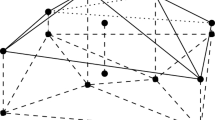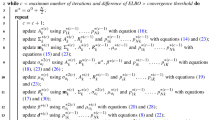Abstract
We model time-varying network data as realizations from multivariate Gaussian distributions with precision matrices that change over time. To facilitate parameter estimation, we require not only that each precision matrix at any given time point be sparse, but also that precision matrices at neighboring time points be similar. We accomplish this with two different algorithms, by generalizing the elastic net and the fused LASSO, respectively. While similar approaches in the literature for modeling time-varying networks have predominantly extended the graphical LASSO of Friedman et al. (Biostatistics 9(3):432-441, 2008), we extend the regression approach of Meinshausen and Bühlmann (Ann Stat 34(3):1436–1462, 2006) and subsequently of Peng et al. (J Am Stat Assoc 104(486):735–746, 2009). This allows us to explicitly focus on and work with the partial correlation coefficients, which are more directly meaningful and interpretable parameters for the biological sciences. We develop efficient algorithms and convenient degree-of-freedom formulae for choosing tuning parameters. The proposed methods are demonstrated through simulation studies. By applying them to an hourly temperature dataset, we detect interesting time-varying connectivity among thirteen Canadian cities. Supplementary materials accompanying this paper appear online.






Similar content being viewed by others
Code Availability
The relevant codes can be found https://github.com/JieJian/TimeVaryingGGM/tree/main/code.
References
Amr A, Xing EP (2009) Recovering time-varying networks of dependencies in social and biological studies. Proc Natl Acad Sci 106(29):11878–11883
Bartlett TE, Kosmidis I, Silva R (2021) Two-way sparsity for time-varying networks with applications in genomics. Ann Appl Stat 15(2):856–879
Boyd S, Parikh N, Chu E, Peleato B, Eckstein J (2011) Distributed optimization and statistical learning via the alternating direction method of multipliers. Found Trends Mach Learn 3(1):1–12201
Chen L-P, Yi GY (2021) Analysis of noisy survival data with graphical proportional hazards measurement error models. Biometrics 77(3):956–969
Chen S, Witten DM, Shojaie A (2015) Selection and estimation for mixed graphical models. Biometrika 102(1):47–64
Danaher P, Wang P, Witten DM (2014) The joint graphical lasso for inverse covariance estimation across multiple classes. J R Stat Soc: Ser B (Stat Method) 76(2):373–397
Dohlman AB, Shen X (2019) Mapping the microbial interactome: Statistical and experimental approaches for microbiome network inference. Exp Biol Med 244(6):445–458
Drton M, Maathuis MH (2017) Structure learning in graphical modeling. Ann Rev Stat Appl 4:365–393
Emmert-Streib F, Glazko GV, De Matos Simoes R (2012) Statistical inference and reverse engineering of gene regulatory networks from observational expression data. Front Genet 3:8–8
Environment and Climate Change Canada. Environment and Climate Change Canada Historical Climate Data website. https://climate.weather.gc.ca/index_e.html, (2022). Accessed 16 Oct 2022
Ferreira LN, Ferreira NCR, Macau EEN, Donner RV (2021) The effect of time series distance functions on functional climate networks. Eur Phys J Spec Top 230(14):2973–2998
Foygel R, Drton M (2010) Extended bayesian information criteria for gaussian graphical models. Adv Neural Inf Process Syst 23
Friedman J, Hastie T, Tibshirani R (2008) Sparse inverse covariance estimation with the graphical lasso. Biostatistics 9(3):432–441
Gibberd AJ, Nelson JDB (2017) Regularized estimation of piecewise constant gaussian graphical models: the group-fused graphical lasso. J Comput Graph Stat 26(3):623–634
Hallac D, Park Y, Boyd S, Leskovec J (2017) Network inference via the time-varying graphical lasso. In: Proceedings of the 23rd ACM SIGKDD international conference on knowledge discovery and data mining, pp 205–213
Han I, Malioutov D, Avron H, Shin J (2017) Approximating spectral sums of large-scale matrices using stochastic Chebyshev approximations. SIAM J Sci Comput 39(4):A1558–A1585
Hoefling H (2010) A path algorithm for the fused lasso signal approximator. J Comput Graph Stat 19(4):984–1006
Kang X, Deng X, Tsui K-W, Pourahmadi M (2020) On variable ordination of modified Cholesky decomposition for estimating time-varying covariance matrices. Int Stat Rev 88(3):616–641
Kittel T, Ciemer C, Lotfi N, Peron T, Rodrigues F, Kurths J, Donner RV (2021) Evolving climate network perspectives on global surface air temperature effects of enso and strong volcanic eruptions. Eur Phys J Spec Top 230(14):3075–3100
Kolar M, Xing EP (2011) On time varying undirected graphs. In: Proceedings of the fourteenth international conference on artificial intelligence and statistics, Fort Lauderdale, vol. 15, pp 407–415
Kolar M, Song L, Ahmed A, Xing EP (2010) Estimating time-varying networks. Ann Appl Stat 4(1):94–123
Lauritzen SL (1996) Graphical models. The Clarendon Press, Oxford
Loh P-L (2017) Statistical consistency and asymptotic normality for high-dimensional robust \(M\)-estimators. Ann Stat 45(2):866–896. https://doi.org/10.1214/16-AOS1471
Meinshausen N (2008) A note on the lasso for gaussian graphical model selection. Stat Probab Lett 78(7):880–884
Meinshausen N, Bühlmann P (2006) High-dimensional graphs and variable selection with the lasso. Ann Stat 34(3):1436–1462
Monti RP, Hellyer P, Sharp D, Leech R, Anagnostopoulos C, Montana G (2014) Estimating time-varying brain connectivity networks from functional MRI time series. Neuroimage 103:427–443
Peng J, Wang P, Zhou N, Zhu J (2009) Partial correlation estimation by joint sparse regression models. J Am Stat Assoc 104(486):735–746
Sato T, Yamanishi Y, Horimoto K, Kanehisa M, Toh H (2006) Partial correlation coefficient between distance matrices as a new indicator of protein–protein interactions. Bioinformatics 22(20):2488–2492
Tibshirani R (1996) Regres Shrinkage Select via lasso. Journal of the Royal Statistical Society. Ser B. 58(1):267–288
Tibshirani R, Saunders M, Rosset S, Zhu J, Knight K (2005) Sparsity and smoothness via the fused lasso. J R Stat Soc. Ser B 67(1):91–108
Tibshirani RJ, Taylor J (2011) The solution path of the generalized lasso. Ann Stat 39(3):1335–1371
Tibshirani RJ, Taylor J (2012) Degrees of freedom in lasso problems. Ann Stat 40(2):1198–1232
Voorman A, Shojaie A, Witten D (2014) Graph estimation with joint additive models. Biometrika 101(1):85–101
Wang S, Xie C, Kang X (2023) A novel robust estimation for high-dimensional precision matrices. Stat Med 42(5):656–675
Whittaker J (1990) Graphical models in applied multivariate statistics. Wiley, Chichester
Xin B, Kawahara Y, Wang Y, Lingjing H, Gao W (2016) Efficient generalized fused lasso and its applications. ACM Trans Intell Syst Technol (TIST) 7(4):1–22
Xue L, Shu X, Annie Q (2020) Time-varying estimation and dynamic model selection with an application of network data. Stat Sin 30(1):251–284
Yang E, Ravikumar P, Allen GI, Liu Z (2015) Graphical models via univariate exponential family distributions. J Mach Learn Res 16(1):3813–3847
Yang J, Peng J (2020) Estimating time-varying graphical models. J Comput Graph Stat 29(1):191–202
Ye GB, Xie X (2011) Split Bregman method for large scale fused Lasso. Comput Stat Data Anal 55(4):1552–1569
Yuan M, Lin Y (2007) Model selection and estimation in the Gaussian graphical model. Biometrika 94(1):19–35
Zhou S, Lafferty J, Wasserman L (2010) Time varying undirected graphs. Mach Learn 80(2–3):295–319
Zou H, Hastie T (2005) Regularization and variable selection via the elastic net. J Roy Stat Soc B 67(2):301–320
Zou H, Hastie T, Tibshirani R (2007) On the “degrees of freedom’’ of the lasso. Ann Stat 35(5):2173–2192
Author information
Authors and Affiliations
Corresponding author
Ethics declarations
Conflict of interest
The authors declared no potential conflicts of interest with respect to the research, authorship and/or publication of this article.
Additional information
Publisher's Note
Springer Nature remains neutral with regard to jurisdictional claims in published maps and institutional affiliations.
Supplementary Information
Below is the link to the electronic supplementary material.
Rights and permissions
Springer Nature or its licensor (e.g. a society or other partner) holds exclusive rights to this article under a publishing agreement with the author(s) or other rightsholder(s); author self-archiving of the accepted manuscript version of this article is solely governed by the terms of such publishing agreement and applicable law.
About this article
Cite this article
Jian, J., Sang, P. & Zhu, M. Two Gaussian Regularization Methods for Time-Varying Networks. JABES (2024). https://doi.org/10.1007/s13253-023-00591-w
Received:
Revised:
Accepted:
Published:
DOI: https://doi.org/10.1007/s13253-023-00591-w




